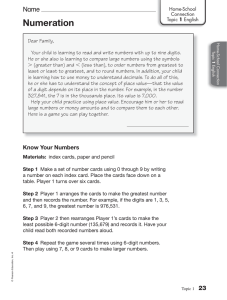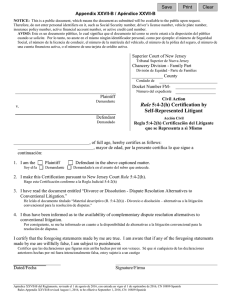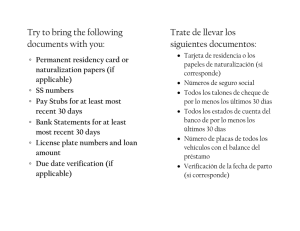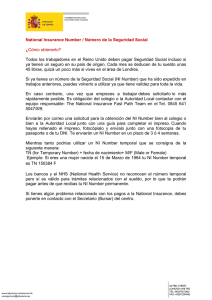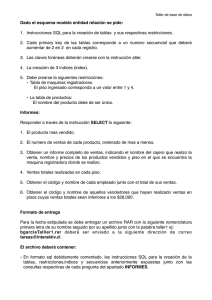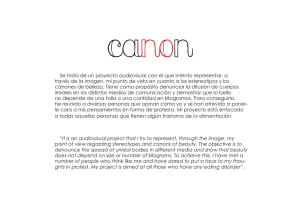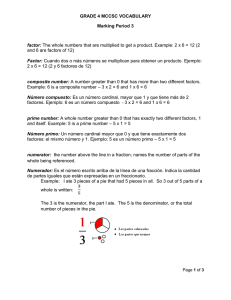UNIT 1. THE NATURAL NUMBERS. DIVISIBILITY
Anuncio
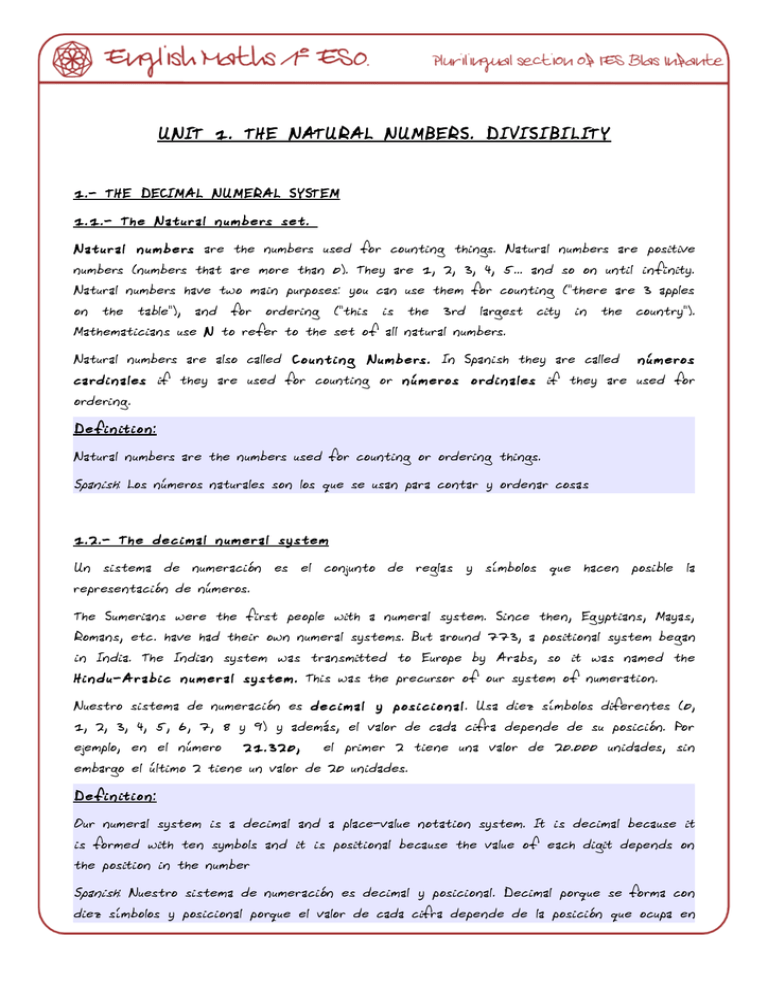
U NIT 1. THE NATURAL NU MBERS. DIVISIBILITY 1.- THE DECIMAL NU MERAL SYSTEM 1.1.- The N atural numbers set. N atural numbers are the numbers used for counting things. Natural numbers are positive numbers (numbers that are more than 0). They are 1, 2, 3, 4, 5... and so on until infinity. Natural numbers have two main purposes: you can use them for counting ("there are 3 apples on the table"), and for ordering ("this is the 3rd largest city in the country"). Mathematicians use N to refer to the set of all natural numbers. Natural numbers are also called Cou nti ng Numbers. In Spanish they are called números cardi nales if they are used for counting or números o rdi nales if they are used for ordering. De fi nitio n: Natural numbers are the numbers used for counting or ordering things. Spanish: Los números naturales son los que se usan para contar y ordenar cosas 1.2.- The decimal numeral system Un sistema de numeración es el conjunto de reglas y símbolos que hacen posible la representación de números. The Sumerians were the first people with a numeral system. Since then, Egyptians, Mayas, Romans, etc. have had their own numeral systems. But around 773, a positional system began in India. The Indian system was transmitted to Europe by Arabs, so it was named the Hi ndu-A rabic numeral system. This was the precursor of our system of numeration. Nuestro sistema de numeración es decimal y posicio nal. Usa diez símbolos diferentes (0, 1, 2, 3, 4, 5, 6, 7, 8 y 9) y además, el valor de cada cifra depende de su posición. Por ejemplo, en el número 21.320, el primer 2 tiene una valor de 20.000 unidades, sin embargo el último 2 tiene un valor de 20 unidades. De fi nitio n: Our numeral system is a decimal and a place-value notation system. It is decimal because it is formed with ten symbols and it is positional because the value of each digit depends on the position in the number Spanish: Nuestro sistema de numeración es decimal y posicional. Decimal porque se forma con diez símbolos y posicional porque el valor de cada cifra depende de la posición que ocupa en el número En el sistema decimal cada posición representa una potencia de 10. Así, empezando por la derecha, la primera posición equivale a 1 unidad, la segunda a 10 unidades, la tercera a 100, etc. Cada posición recibe un nombre en función de su valor: Exercise: Write a number with 8 digits over the lines and translate the following words: ___ ___ ___ ___ ___ ___ ___ ___ Units or Ones:__________ Tens : __________ Hundreds: ___________ Thousands:_____________ Ten thousands: __________ Hundred thousands: ______ Millions:_______________ Ten millions: ___________ Un número puede descomponerse en suma de productos que expresen el valor de cada una de sus cifras en función de su posición o al revés: Solved example: 1.- Write the number 12.034.152 as an addition 12.034.152 = 1x10.000.000 + 2x1.000.000 + 3x10.000 + 4x1.000 + 1x100 + 5x10 + 2x1= In Spanish: 1 Decena de Millón + 2 Unidades de Millón + 3 Decenas de Millar + 4 Unidades de Millar + 1 Centena + 5 Decenas + 2 Unidades In English: 1 Ten Millions + 2 Millions + 3 Ten Thousands + 4 Thousands + 1 Hundreds + 5 Tens + 2 Units 2.- Find out the number represented by 3 Millions + 3 Hundred Thousands + 12 Thousands + 35 Tens + 2 Units. Hay dos formas de hacer este ejercicio: Calculando el valor de cada cifra según su posición y sumando: 3 Millions = 3 x 1.000.000 = 3.000.000 3 Hundred Thousands = 3 x 100.000 = 300.000 12 Thousands = 12 x 1.000 = 12.000 35 Tens = 35 x 10 = 350 2 Units = 2 x 1 = 2 3.312.352 Dibujando líneas con los nombres de las posiciones y colocando las cantidades una por una. Si una cantidad tiene más de una cifra entonces hay que escribirla empezando en su correspondiente posición pero hacia la izquierda. ___ ___ ___ . ___ ___ ___. ___ ___ ___ H T U H T U H T U S olve the following exercises: 1A.- Write the numbers below as an addition in English and in Spanish like the solved example above. a) 12.004.23: b) 103.245.023; 2A.- Find out the numbers which are formed by the following values: a) 13 Unidades de Millón + 52 Unidades de Millar + 3 Centenas + 24 Unidades = b) 12 Centenas de Millón + 124 Decenas de Millar + 34 Decenas + 5 Unidades = c) 2 Thousand Millions + 3 Millions + 5 Ten Thousands + 2 Thousands + 3 Hundreds + 5 Units d) 3 Hundred Millions + 12 Millions + 134 Hundreds + 12 Units = 1.3.- Represe ntatio n and o rderi ng The natural numbers can be represented on a half li ne (semirrecta) (line with a fixed beginning and with no fixed ending) that begins with zero and which is divided in equal segments. 0 1 2 3 4 5 6 7 8 Esta representación puede usarse para ordenar los números. Un número es mayor que otro si está situado más a la derecha en la semirrecta. To compare two numbers, we can use three symbols: > (greater than: mayo r que), = (equal to: igual a) ; < (less than: me no r que). S olve the exercise: 3A.- Put the corresponding symbols between the following numbers: 5 ___ 7 1003 ____1030 10020 ___10200 2.- READING AND WRITING NU MBERS 2.1.- Describi ng a number i n wo rds 9898____ 9799 Para leer un número la forma más fácil es usar los separadores de miles cada tres cifras empezando por el final. Después nombraremos los puntos (mil, millón, mil, billón, etc.). Para leer el número iremos leyendo cada grupo de tres cifras y a continuación el nombre del punto. Solved example: 3.- Describe in words the number 12.045.235.003.134: • Primero nombraremos cada uno de los puntos del número: 12.045.235.003.134 Billio n Thousand Millio n Mil Millón Billón • Thousa nd Mil Ahora leeremos cada grupo de tres números y después el nombre del punto: Twelve billio n forty five thousand two hundred and thirty five millio n th ree thousand o ne h undred a nd thirty four. Doce billo nes cuare nta y cinco mil doscie ntos treinta y cinco millo nes tres mil cie nto treinta y cuat ro. (Note: In English, 12,045,235,003,134) numbers are written using commas instead of dots. Example: Solve the exercise: 4A.- Describe the following numbers in words, in Spanish and in English: a) 34.000.340.02: b) 3.004.000.123.004: c) 12.005.000.012.300: d) 373.005.000.000.345 2.2.- W riting an amou nt i n figures: Para escribir una determinada cantidad en cifras numéricas subraya todas las palabras que hagan referencia al nombre de un separador de miles (millón, mil, etc.). Escribe los puntos separados por un espacio, deberás de empezar por el mayor que aparezca y escribirlos todos hasta llegar al separador de mil. Por último escribe entre los puntos los grupos de números completando hasta t res cifras e n cada caso. Solved example: 4.-Write ten billion one hundred thirteen million two thousand twenty three in figures: • Primero subrayaremos todas las palabras que hagan referencia a mil, millón, billón, etc: te n billio n o ne h undred thirtee n millio n two thousand twe nty th ree diez billo nes cie nto trece millo nes dos mil veintitres • Ahora tenemos que escribir empezando por el mayor.(Hay que escribirlos todos aunque no se nombren en el número) • . . . . Billio n Thousa nd Millio n Thousa nd Billón Mil Millón Mil Tenemos que escribir las cantidades entre los puntos, siempre completando con ceros para que haya tres cifras entre cada dos puntos: 10.000.113.002.023 Solve the exercise: 5A.- Write the following amounts in figures: a) Cuarenta billones tres mil millones ciento cuarenta mil b) Trece billones, doscientos mil tres millones ciento doce mil cuatro c) Twelve billion two hundred and forty thousand million three hundred thousand and five d) Four billion twenty seven thousand two million five thousand three hundred and fifteen e) Fifteen billion forty five thousand three hundred and twenty four, six million and two hundred 3.- OPERATION S WITH NATURAL NU MBERS 3.1.- Additio n Adding is the same as putting together or joining two values into one. Es reunir, juntar, añadir. We read 3 + 5 = 8 like: “Three plus five is equal to eight” or “Three plus five equals eight” or “Three plus five is eight”. Terms in the addition are called adde nds and the result is called the sum. In Spanish the addends are the sumandos. Solved Example: 5.- The library has lent 45 books last Monday, 50 books on Tuesday and 73 books on Wednesday. How many books have they lent? 45 + 50 + 73 = 168 books. Answer: They have lent 168 books 3.2.- The properties o f additio n The properties are the closure, commutative, associative, and additive identity Closure property: Addition of two natural numbers is always another natural number. For example 6 + 7 = 13 Commutative property: When two natural numbers are added, the sum is the same regardless of the order of the addends. a+ b = b + a. For example 4 + 2 = 2 + 4 Associative Property: When three or more natural numbers are added, the sum is the same regardless of the grouping of the addends. a + b + c = (a + b) + c = a + (b + c). For example (2 + 3) + 4 = 2 + (3 + 4) Additive Ide ntity Property: The sum of any natural number and zero is the original number. For example 5 + 0 = 5. De fi nitio n: (Try to translate the properties into Spanish) Ley de Composición i nterna: La suma de dos números naturales es siempre otro número natural Propiedad Co nmutativa: El orden de los sumandos no altera la suma Propiedad Asociativa: Al sumar varios sumandos no importa como se agrupen el resultado es siempre el mismo Eleme nto neut ro: Existe un elemento neutro que sumado a cualquier número lo deja igual. Es el cero 3.3.- S ubt ractio n o f natural numbers Subtracting is removing or taking away some objects from a group. Es quitar, eliminar. We read 13 – 7 = 6 like: “Thirteen subt ract seven equals six” (sometimes you can see “thirteen take away seven equals six” but it is better to use the first expression. The terms of subtraction are called mi nue nd and subt rahe nd, the outcome is called the differe nce. The mi nue nd is the first number, it is the number from which you take something and it must be the larger number. In Spanish it is called mi nue ndo The subt rahe nd is the number that is subtracted and it must be the smaller number. In Spanish it is called sust rae ndo The differe nce is the result of the subtraction. In Spanish it is called difere ncia To check if the subtraction is correct we add up the subtrahend and the difference. The outcome must be the minuend. Prueba de la resta: Minuend = Subtrahend + Difference; And in Spanish: Minuendo = Sustraendo + diferencia Solved example: 6.- We have saved 3520 euros but we have spent € 745 on a computer. How much money is left? 3520 – 745 = 2775. Answer: 2775 euros is left. 3.4.- Multiplicatio n Multiplying is doing an addition of equal addends. Es hacer una suma de sumandos iguales. 3 + 3 + 3 + 3 + 3 = 3 x 5 = 15 We read 3 x 5 = 15 like: “Three times five equals fifteen” or “Three times five is fifteen” The facto rs are the numbers that are multiplied together. The product is the result of multiplying. Solved Example: 7.- In my living-room I have a bookcase (estantería) with three shelves (estantes). If there are five books on each shelf, how many books are there? 5 x 3 = 15 Answer: I have 15 books in my bookcase 3.5.- The properties o f multiplicatio n The properties are the closure, commutative, associative, and additive identity. Closure property: Multiplication of two natural numbers is always another natural number. For example 6 x 7 = 42 Commutative property: When two numbers are multiplied together, the product is the same regardless of the order of the factors. For example 4 x 2 = 2 x 4 Associative Property: When three or more numbers are multiplied, the product is the same regardless of the grouping of the factors. For example: Multiplicative (2 x 3) x 4 = 2 x (3 x 4) Ide ntity Property: The product of any number and o ne is that number. For example 5 x 1 = 5. De fi nitio n: (Try to translate the properties into Spanish) Ley de Composición i nterna: El producto de dos números naturales es siempre otro número natural Propiedad Co nmutativa: El orden de los factores no altera el producto Propiedad Asociativa: Al multiplicar varios números no importa como se agrupen, el resultado es siempre el mismo Eleme nto neut ro: Existe un elemento neutro que multiplicado por cualquier número lo deja igual. Es el uno 3.6. Divisio n Dividing is to share a quantity into equal groups. Es repartir en partes iguales. It is the inverse of multiplication. In Spanish we write 6 : 2 , but in English it is always 6 ÷ 2 and never with the colon (:). We read 15 ÷ 5 = 3 like: “Fifteen divided by five equals three” There are four terms in a division: divide nd, diviso r, quotie nt and remai nder. The divide nd is the number that is divided. In Spanish is divide ndo The divisor is the number that divides the dividend. In Spanish is diviso r The quotie nt is the number of times the divisor goes into the dividend. In Spanish is cocie nte The remainder is a number that is too small to be divided by the divisor and in Spanish is called resto. Solved Example: 8.- There are 72 sweets in a bag. If we want to distribute them to 12 children, How many sweets are there for each child? 72 : 12 = 6 Answer: Six sweets for each child. La división puede ser: a) Exacta: Tiene resto cero b) Entera: Tiene resto distinto de cero. To check if the division is correct we do the divisio n algo rithm (prueba de la división): Divisio n Algo rithm: Dividend = Divisor x Quotient + Remainder; And in Spanish: Divisor x Cociente + Resto Solved example: 9.- Find out the outcome of the division 237 : 13 and then check the result with the division algorithm: 237 : 13 = 18 Remainder = 3 Dividend = Divisor x Quotient + Remainder; 13 x 18 + 3 = 237 so it is correct 4. COMBINED OPERATION S 4.1.- Dist rib utive property: La suma de dos números multiplicada por un tercero es igual a la suma del producto de cada término de la suma por el tercer número. For example 4 x (6 + 3) = 4 x 6 + 4 x 3. Así que para hacer la multiplicación de un número por un paréntesis que tiene una suma: 12 x ( 3 + 5 ) = 12 x 8 = 96 12 x ( 3 + 5 ) = 36 + 60 = 96 First, the brackets and then the multiplication Applying the distributive property. Solved example: 10.- Do the operation 5 x (12 + 45) in two different ways: 5 x (12 + 45 ) = 5 x 57 = 285 First, the brackets 5 x (12 + 45) = 60 + 225 = 285 Applying the distributive property Solve the exercise: 6A.- Do the following operations in two different ways: a) 12 x (12 + 4) = b) 3 x (2 + 1 + 7) = c) (12 + 30) x 5 4.2.- O rder o f the operatio ns When expressions have more than one operation, we have to follow rules for the order of operations: Regla 1: Primero se hace cualquier operación entre paréntesis. Regla 2: Después multiplicaciones y divisiones, de izquierda a derecha. Regla 3: Por último sumas y restas, de izquierda a derecha. To remind this you can use the BOD MAS rule: B: Brackets O: Orders (potencias) D M: Divisions and Multiplications A S: Additions and subtractions Solved Examples: 11.- Solve 3 + 6 x (5 + 4) ÷ 3 - 7 using the order of operations. Step 1: 3 + 6 x (5 + 4) ÷ 3 - 7 = 3 + 6 x 9 ÷ 3 - 7 Brackets Step 2: 3 + 6 x 9 ÷ 3 - 7 = 3 + 54 ÷ 3 - 7 Multiplication Step 3: 3 + 54 ÷ 3 - 7 = 3 + 18 - 7 Division Step 4: 3 + 18 - 7 = 21 - 7 Addition Step 5: 21 - 7 = 14 Subtraction 12.- Evaluate 9 - 5 ÷ (8 - 3) x 2 + 6 using the order of operations. Step 1: 9 - 5 ÷ (8 - 3) x 2 + 6 = 9 - 5 ÷ 5 x 2 + 6 Brackets Step 2: 9 - 5 ÷ 5 x 2 + 6 = 9 - 1 x 2 + 6 Division Step 3: 9 - 1 x 2 + 6 = 9 - 2 + 6 Multiplication Step 4: 9 - 2 + 6 = 7 + 6 Subtraction Step 5: 7 + 6 = 13 Addition Como ves en los ejemplos anteriores las multiplicaciones y divisiones o las sumas y las restas se van realizando de izquierda a derecha, nunca de dos en dos. Si dentro de un paréntesis hay varias operaciones volveremos a aplicar la regla BODMAS a su vez dentro del paréntesis como se ve en el siguiente ejemplo: 13.- Evaluate 150 ÷ (6 + 3 x 8) - 5 using the order of operations. Solution: Step 1: 150 ÷ (6 + 3 x 8) - 5 = 150 ÷ (6 + 24) - 5 Multiplication inside Step 2: 150 ÷ (6 + 24) - 5 = 150 ÷ 30 - 5 Addition inside Step 3: 150 ÷ 30 - 5 = Division brackets brackets 5 - 5 Step 4: 5 - 5 = 0 Subtraction Solve the exercise: 7A.- Solve using the order of operations: a) 5 + 2 x (10 – 2 x 5 + 1) – 3 = b) 10 – 3 x 2 + 35 : (5 – 4 + 3 x 2) = 5.- SOLVING PROBLEMS In order to solve problems you must follow the rules below: 1. Start with a first reading of the problem to know what it is about. 2. Then you do a second reading more slowly, in order to understand the problem and find out what data they provide: 3. Write down the data of the problem clearly. If it is a geometric problem, then you can make a drawing. You must also check that the units are all the same. If they are not, then you will have to change them to the appropriate ones: 4. Now you can solve the problem. In this step you do all the necessary operations to solve the problem: 5. Finally, answering: Reread the question of the problem and answer it with a sentence. Don't forget to mention the correct unit and check that the answer makes sense: 1.- Lee el problema una vez para saber de qué va 2.- Haz una segunda lectura para entender mejor el problema y localizar los datos 3.- Escribe los datos. Si es un problema geométrico podrás hacer un dibujo. Comprueba que todas las unidades son las mismas y si no deberás cambiarlas 4.- Resuelve el problema. Haz todas las operaciones necesarias 5.- Da una respuesta. Lee de nuevo la pregunta del problema y contesta con una frase. No olvides las unidades y comprueba que la respuesta tiene sentido Solved example: 14.- John has saved 350 euros in his bank account. He has received 37euros as a birthday present and then, he has bought 4 DVDs which cost 15€ each. How much money does he have now? DATA SOLVE Saved: 350euros 350 + 37 = 387 euros Gift: 37euros 4 x 15 = 60 euros Spent: 4 x 15euros 387 – 60 = 327euros ANSWER A: Now, he has 327euros Solve the exercise: 8A.- A bookshop buys 50 books at 11euros each. If they sell them at 15€ each, How much money will they make? 9A.- Compramos 12 libros a 15 euros cada uno ¿A cuánto deberíamos de vender cada libro para ganar en total 60 euros? 6.- MU LTIPLES AND FACTORS 6.1.- Co ncept o f multiple We say that a number a is a multiple of another number b if the division a : b is an exact division, that is, if b contains a a whole number of times. And in Spanish: U n número a es múltiplo de ot ro número b si la división a: b es exacta Para obtener los múltiplos de un número lo multiplicamos por 1, 2, 3 y así sucesivamente. Solved Example: 15.- Obtain some multiples of 3, 5 and 7: 3x1, 3x2, 3x3, 3x4, 3x5, 3x6 .... so Multiples of 3 = 3, 6, 9, 12, 15, 18, ..... 5x1, 5x2, 5x3, 5x4, 5x5, 5x6 .... so Multiples of 5 = 5, 10, 15, 20, 25, 30, ..... 7x1, 7x2, 7x3, 7x4, 7x5, 7x6 .... so Multiples of 7 = 7, 14, 21, 28, 35, 42, ..... 6.2.- Co ncept o f facto r We say that a number b is a facto r of another number a if the division a : b is an exact division. A nd i n Spanish: U n número es diviso r de ot ro número a si la división a : b es u na división exacta Por tanto, si la división a : b es exacta, entonces a (el número más grande) es el múltiplo y b (el número más pequeño) es el divisor. Para encontrar los divisores de un número debemos hacer probar a dividir por todos los números naturales que son más pequeños que él. Pero hay un pequeño truco que es irlos agrupando por parejas de divisores: Empezamos dividiendo por 1, 2, 3... y si encontramos un divisor el cociente es otro divisor. Seguimos así hasta que empiecen a repetirse. Solved Example: 16.- Obtain all the factors of 90: 90 : 1 = 90; 90 : 2 = 45; 5 = 18; 90 : 6 = 15; 90 : 10 = 9 90 : 3 = 30; 90 : 7 = n. p.; 90 : 4 = not possible; 90 : 8 = n.p.; 90 : 9 = 10; (10 and 9 is repeated, so we are done) So, the factors of 90 are: 1, 2, 3, 5, 6, 9, 10, 15, 18, 30, 45, 90 Solve the following exercises: 10A.- Find three multiples of 11 that are between 27 and 90. 11A.- Work out if 556 is a multiple of 4 12A.- Find out if 12 is a factor of 144 13A.- Which of these numbers is a factor of 91? a) 3 b) 7 c) 11 d) 13 14A.- Work out all the factors of the following numbers: a) 24 b) 27 c) 48 d) 25 e) 7 f) 56 15A.- Point out which of these numbers have exactly three factors. a) 4 b) 25 c) 15 d) 49 6.3.- The properties o f multiples and facto rs Multiples Facto rs a) Every number is the mutiple of itself a) Every number is the factor of itself Cada número es múltiplo de sí mismo Todo número es diviso r de si mismo Example: 3 is the multiple of 3 Example: 3 is the factor of 3 90: Multiples Facto rs b) Every number is the multiple of 1: b) 1 is the factor of any number Todos los números so n múltiplos de 1 1 es diviso r de cualquier número Example: 7 is the multiple of 1 Example: 1 is the factor of 7 c) Zero is the multiple of any number c) Zero is not the factor of any number cero es múltiplo de cualquier número Cero no es diviso r de ningún número Example: 0 is the multiple of 3 Example: Zero is not the factor of 2 d) Every number has an infinite number of d) The set of the factors of a number is multiples. finite Todos los números tie ne n i n fi nitos El co nju nto de diviso res de u n número múltiplos es fi nito 7.- PRIME AND COMPOSITE NU MBERS Si miras al ejercicio anterior habrás visto que hay números que sólo tienen dos divisores, son los números primos. Otros, sin embargo tienen más de dos divisores y se llaman números compuestos. So, a prime number only has two factors: the number one and itself. For example: 3, 5, 11, 17, etc. A composite number has more than two factors. For example: 4, 9, 15, 30, etc. An in Spanish: U n número primo es el que tie ne dos diviso res y u n número compuesto tie ne más de dos diviso res Para averiguar si un número es primo o compuesto puedes hallar sus divisores, o bien dividirlo por todos los números primos menores que él, si no encuentras ningún divisor, entonces el número es primo. A smart procedure to find the first prime numbers is the Sieve of Erathostenes. It consists of a table with the numbers from 1 to 100, like the one below, and now do the following rules: ● Number 2 is prime. Circle it, then cross out all the multiples of 2 Circle the next number that is not crossed out (3) because it is prime too. And then, cross out all its multiples. Continue in this way, that is, circle the numbers which are not crossed out and cross out all its multiples until you finish with the table. Then you will have got the first prime numbers lower than 100. 1 2 3 4 5 6 7 8 9 10 11 12 13 14 15 16 17 18 19 20 21 22 23 24 25 26 27 28 29 30 31 32 33 34 35 36 37 38 39 40 41 42 43 44 45 46 47 48 49 50 51 52 53 54 55 56 57 58 59 60 61 69 70 71 72 73 74 75 76 77 78 79 80 81 82 83 84 85 86 87 88 89 90 91 92 93 94 95 96 97 98 99 100 62 63 64 65 66 67 68 Solve the following exercises: 16A.- Work out the factors of the numbers below and then point out which ones are prime numbers. a) 8 b) 101 c) 57 49 8.- DIVISIBILITY RU LES Las reglas de divisibilidad te ayudan a saber si un número es múltiplo de otro sin hacer la división. Rule of number 2: A number is divisible by 2 if its last digit is either 0 or an even number. Un número es divisible por 2 si su última cifra es 0 ó un número par. Example: 46, 200, 34, 108..... Rule of number 3: A number is divisible by 3 if the sum of its digits is a multiple of 3. Un número es divisible por 3 si la suma de sus cifras es múltiplo de 3. Example: 45, 105, 300, 417.... Rule of number 4: A number is divisible by 4 if its two last digits are multiples of 4. Un número es divisible por 4 si sus dos últimas cifras son múltiplo de 4. Example: 100, 224, 340, 664.... Rule of number 5: A number is divisible by 5 if it ends in 0 or 5. Un número es múltiplo de 5 si acaba en 0 ó 5. Example: 200, 345, 650, 800 ..... Rule of number 9: A number is divisible by 9 if the sum of its digits is a multiple of 9. Un número es divisible por 9 si la suma de sus cifras es múltiplo de 9. Example: 81, 333, 450, 1278..... Rule of number 10: A number is divisible by 10 if it ends in 0. Un número es divisible por 10 si acaba en 0. Example: 30, 400, 500. Rule of number 11: A number is divisible by 11 if the difference between the sum of the digits on odd positions and the sum of the digits on even positions is 0, 11 or a multiple of 11. Un número es divisible por 11 si la diferencia entre la suma de las cifras en posición par y la suma de las cifras en posición impar es 0, 11 o un múltiplo de 11. Example: 121, 3652 Solve the following exercises: 17A.- Use the divisibility rules to complete the following table: Divisible by 2 3 4 5 9 10 11 25 100 375 990 1.848 12.300 14.240 18A.- Find out two numbers with five digits that are divisible by both 2 and 5 and aren't divisible by 100 19A.- Write down two numbers with five digits that are multiples of: a) 3 and 11 but not of 9 b) 9 and 11. Are they multiples of 3? 9.- PRIME FACTOR DECOMPOSITION OF A NU MBER Cada número compuesto puede escribirse como un producto de números, a veces incluso como varios productos distintos: Example: 15 = 5 x 3 24 = 2 x 12 = 3 x 8 = 3 x 2 x 4 = 24 x 1= .... Pero cada número puede ser escrito únicamente como un producto de números primos que es único. Encontrar ese producto es lo que llamamos descomposición e n facto res primos. In English we call it prime facto r decompositio n of a number. Si tenemos un número pequeño podemos hacer la descomposición mentalmente, pero recuerda sólo puedes usar números primos 3 Example: 6 = 2 x 3; 24 = 4 x 6 = 2 x 2 x 2 x 3 = 2 x 3 Si tenemos un número mayor haremos divisiones sucesivas empezando por 2, cuando termines por 3 (sólo divisores primos). El producto de todos los divisores es la descomposición en factores primos. Solved Example: 18.- Work out the prime decomposition of 3600 4 2 2 3600 = 2 x 3 x 5 Hint: If the number ends in zero, you can change each zero by the factors 2 x 5, so if the 2 2 last two digits are zeros, the prime decomposition will have 2 x 5 . Truco: Cuando el número acabe en 0, se puede cambiar cada cero por los factores 2 x 5, así que si las dos últimas 2 2. cifras son cero la descomposición en factores primos tendrá 2 x 5 Solved Example: 19.- Work out the prime decomposition of 25000 and 180000 3 3 2 3 3 3 5 25000 = 25 x 2 x 5 = 5 x 2 x 5 = 2 x 5 4 4 2 4 4 5 2 4 180000 = 18 x 2 x 5 = 2 x 3 x 2 x 5 = 2 x 3 x 5 Solve the following exercises: 20A.- Work out the prime factor decomposition of the following numbers: a) 108 b) 99 c) 42 d) 37 e) 100 21A.- Complete these prime factor decompositions: ? 2 a) 360 = 2 x ? x 5 2 2 b) 300 = ? x ? x 5 10.- THE HIGHEST COMMON FACTOR AND THE LEAST COMMON MU LTIPLE 10.1.- Co ncept o f the highest commo n facto r (HCF) f) 840 Vamos a calcular los divisores de varios números, por ejemplo 30, 48, 54. Puedes mirar el apartado 1.2 si no recuerdas como se hacía. Factors of 30: 1, 2, 3, 5, 6, 10, 15, 30 Factors of 48: 1, 2, 3, 4, 6, 8, 12, 16, 24, 48 Factors of 54: 1, 2, 3, 6, 9, 18, 27, 54 Ahora vamos a elegir los divisores comunes a los tres números: Factors of 30: 1, 2, 3, 5, 6, 10, 15, 30 Factors of 48: 1, 2, 3, 4, 6, 8, 12, 16, 24, 48 Factors of 54: 1, 2, 3, 6, 9, 18, 27, 54 Cuál es el mayor de todos? Es el 6 por lo que el máximo común divisor de 30, 48 y 54 es el 6 De fi nitio n: The highest common factor of several numbers is the largest number that evenly divides into all of them An in Spanish: El máximo común divisor de varios número es el mayor número que los divide a todos 10.2.- Rule fo r calculati ng the h.c.f A veces puede llevar mucho tiempo averiguar todos los divisores de varios nombres por lo que hace falta un método más sencillo. Regla: “To work out the hcf of several numbers, first you have to find the prime factor decomposition of the given numbers and then, to take the common factors with the least index”. And in Spanish: Para clacular el m.c.d. de varios números, primero se descomponen en factores primos y después se toman los factores comunes con el menor exponente Solved example: 20.-Find out the hcf of numbers 36, 48 y 90. 1.- Write them as a product of prime factors: 2 2 36 = 2 · 3 4 48 = 2 ·3 2 90 = 2 · 3 · 5 2.- Take the common factors with the least index: h.c.f. = 2 · 3 = 6 We can also do it in the English way. It consists of writing all the factors of each number in a row and then mark the common ones. 36 = 2 · 2 · 3 · 3 48 = 2 · 2 · 2 · 2 · 3 90 = 2 · 3 · 3 ·5 Señalamos los factores que sean comunes en los tres números: 36 = 2 · 2 · 3 · 3 48 = 2 · 2 · 2 · 2 · 3 m.c.d. = 2 · 3 = 6 90 = 2 · 3 · 3 ·5 Solve the following exercises: 22A.- Work out the factors of the numbers below and then find out the hcf: a) 2 and 16 b) 3 and 25 c) 9, 12 and 18 d) 27, 36 and 63 23A.- Find out the hcf of the following numbers using the Spanish and the English methods: a) 4, 6, 18 and 32 b) 3, 4, 12, 36 and 48 10.3.- Co ncept o f the least commo n multiple (lcm) En este caso vamos a hallar los múltiplos de varios números, por ejemplo 2 y 3: Multiples of 2: 2, 4, 6, 8, 10, 12, 14, 16, 18, 20, 22, 24, 26, 28, 30, 32,... Multiples of 3: 3, 6, 9, 12, 15, 18, 21, 24, 27, 30, 33, 36,.... Ahora, escogeremos los múltiplos comunes de ambos números: Multiples of 2: 2, 4, 6, 8, 10, 12, 14, 16, 18, 20, 22, 24, 26, 28, 30, 32,... Multiples of 3: 3, 6, 9, 12, 15, 18, 21, 24, 27, 30, 33, 36,.... ¿Cuál es el más pequeño? Es 6 por tanto 6 es el mínimo común múltiplo de 2 y 3. De fi nitio n: The least common multiple of several numbers is the smallest number that is multiple of all of them. And in Spanish: El menor común múltiplo de varios números es el menor número que es múltiplo de todos ellos 10.4.- Rule fo r calculati ng the lcm Como en el caso del m.c.d. necesitamos una regla mas fácil para calcular el m.c.m. sin necesidad de halar todos los múltiplos de los números. esta regla es: Regla: “To work out the lcm of several numbers, first write them as a product of their prime factors and then take the common and non-common factors with the highest index.” And in Spanish: Para calcular el m.c.m. De varios números, primero se halla la descomposición en factores primos y después se toman los comunes y no comunes con el mayor exponente. Solved example: 21.- Find out the lcm of numbers 36, 48 and 90 1.- First obtain the prime factor decomposition: 36 = 22 · 32 48 = 24 ·3 90 = 2 · 32 · 5 2.- Now, take the common and non-common factors with the highest index: l.c.m = 24 · 32 · 5 = 720 A pesar de tener estas reglas es una buena idea acostumbrarse a calcular el m.c.d. y m.c.m. mentalmente cuando los números son pequeños. Sólo tienes que pensar en un múltiplo pequeño o en un divisor grande de los números dados. Solved example: 22.- Find out mentally the hcf and the lcm of the numbers below: a) 3 and 5; hcf = 1 lcm = 15 b) 2 and 4; hcf = 2 lcm = 4 c) 6 and 15; hcf = 3 lcm = 30 Solve the following exercises: 24A.- Work out the l.c.m. of the numbers below: a) 9, 12 and 18 b) 27, 36 and 63 25A.- Work out the l.c.m. of the following numbers. What conclusion do you reach? a) 2, 4, 8 and 16 b) 3, 4, 6 and 12 U NIT 1: THE NATURAL NU MBERS SET. REVISION SHEET • To master the definitio ns and theory o f the unit / Dominar las definicio nes y aspectos teóricos del tema 1.What are the natural numbers used for? What numbers are they? What are they called in Spanish? 2.¿Qué es un sistema de numeración? 3.Our numeral system is decimal and positional, what does it mean? (Answer in Spanish if you prefer) 4.Write the name of the different place-values in a number in English and in Spanish. 5.What properties do the addition and multiplication of natural numbers have? Write the name in Spanish and English and the definition only in Spanish. 6.The operation 6 x (2 + 3) can be done in two different ways. What is the name of this property ? Answer in Spanish and in English 7.If you have several combined operations, what is the order you have to follow? Try to answer in English. 8.What are the two operations related to an addition? And to a division? Try to answer in English. • To k now how to describe a number in words or how to write it in figures, with at least nine digits al me nos nueve cifras / Saber leer y escribir números de 9. Describe the following numbers in words in Spanish and English: a) 15.002.365 b) 152.365.001 c) 636.004.600.003 10.Write the following numbers in figures: a) Dos billones trescientos mil millones ciento uno b) Trece mil doscientos millones treinta y una mil cuarenta y cinco c) Fourteen thousand twenty million five hundred four thousand and three d) Two billion three hundred forty five thousand twenty million ten thousand and two hundred. • To write the decimal decompositio n o f a number a nd to write a number k nowing its decimal decompositio n/ Obte ner la descomposición decimal de un número descomposición decimal y escribir un número a partir de sus 11. Write the decomposition of the following numbers. Write the place values in English and in Spanish. a) 25.062.123 b) 159.001.153 c) 354.078.001.023 12. Write the numbers described by: a) 132 Miles de millón + 32 Unidades de millar + 45 Decenas + 3 Unidades: b) 2 Decenas de millón + 23 Decenas de millar + 362 Decenas: c) 24 Thousands of Millions + 5 Hundreds of Thousands + 124 Thousands + 3 Units d) 5 Hundreds of Millions + 23 Millions + 55 Tens of Thousands + 34 Hundreds + 5 Units • To do the four basic operatio ns with natural numbers / Realizar las cuat ro operacio nes básicas co n números naturales 13. Find out the outcome of the following operations: a) 23.754 + 751.908 + 5.737 + 837 = b) 746.883 – 12.888 = c) 7366 x 778 = d) 8438 x 2004 = e) 37563 : 705 = f) 73747 : 3200 = • To solve combined operatio ns with a nd without b rackets / Realizar operacio nes combinadas co n y sin paréntesis . 14.- Do the next combined operations following the rules for the order of operations: a) 2 – 10 : 10 + 3 x (1 + 3) = b) 25 – 3 x 4 + 2 x 5 – 1 = c) (4 + 5 ) : 3 – (1 + 2) + 2 x 4 = d) 36 – 10 : 2 + 4 x (8 – 3 x 2 + 5) = e) (34 – 12) x 3 + 36 : (4 + 8) = f) 6 – 3 x (2 + 3 x 2 – 5) – 10 : 2 = • To solve problems that use operatio ns with natural numbers / Resolver problemas que use n operacio nes co n números naturales 15. One cyclist has cycled 78 km of the 153 that a stage is. How many kilometres does he still have to cycle? 16. Milo has bought 10 tickets to the theatre and Gloria buys another 8 for the pupils who have decided to come at the last minute. How much do they have to pay between them if each tickets costs 9€? 17. Five brothers and sisters receive 24.300 € each as an inheritance from their uncle Tom. How much would they receive if there were only three of them? 18. The sum of three numbers is 450. The two smallest ones are 75 and 124. What is the other number?
